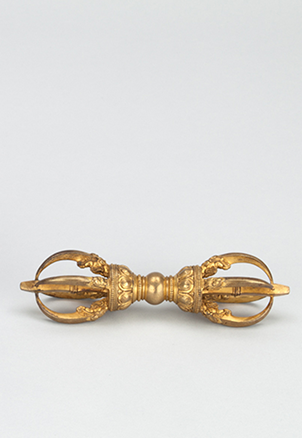
The vajra is the essential symbol of the secret tantric path in Buddhism, which is known as the Vajrayana, the vajra vehicle. It lends its name to an array of deities like Vajrapani and Vajrasattva, as well as to qualities that are created by the transformation of tantric practices (like Vajra mind). Vajra means hard or indestructible, and its Tibetan name dorje means “lord of stones” or diamond. Tantric practices are believed to be a sure means of creating an awakened mind of Buddhahood, which is indivisible and indestructible. The vajra in particular represents the perfection of method or skillful means, an active compassion that is considered to be masculine, which is ultimately inseparable from the feminine wisdom that realizes the true nature of reality, symbolized by the bell. Keeping in mind this inseparability, the practitioner holds the vajra in the right hand and the bell in the left hand while performing rituals.
The vajra was originally the thunderbolt of Indra, the Hindu god who brought the monsoon rains (similar to the Norse god Thor and the Greek god Zeus). According to a Buddhist legend, the Buddha took Indra’s open-pronged weapon and bent the prongs inward, transforming it into a peaceful scepter. According to the principle of skillful means, it can be used in peaceful or wrathful ways, according to the needs of the situation. The five prongs of a vajra, one projecting straight through the center and four curved around the edges, form a mandala, evoking the mandalas of the five tantric Buddhas or the five components of the individual’s body and mind. The sphere in the center and the open space in between the prongs indicate the empty nature of all reality.
Come view our Art of the Week on the exhibition Gateway to Himalayan Art.
- https://dev.rubinmuseum.org/images/content/7126/vajra__zoom.png
- https://dev.rubinmuseum.org/images/content/7126/vajra__zoom.png

